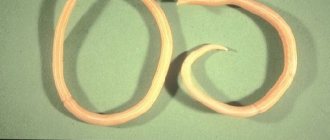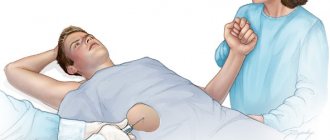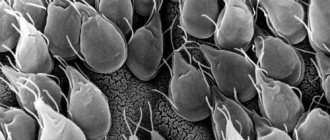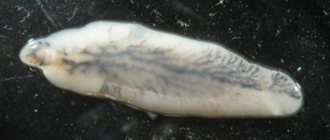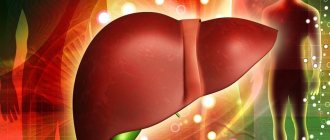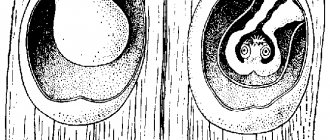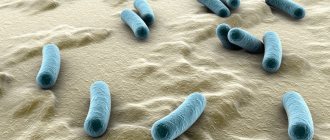Enterobiasis is an infectious disease caused by the helminth pinworm, in which a person is bothered by various allergic reactions and itching around the anus. The worm belongs to the class of roundworms. In Latin, pinworm sounds like Enterobius vermicularis. Having deciphered the name of the helminth into Russian, you can immediately guess where this parasite lives and what it affects. Enteros is Latin for “intestines,” bios means “life,” and vermicularis means “little worm.” That is, the main habitat of the pinworm is the intestines. Let's take a closer look at why pinworms appear in adults, the symptoms and treatment of infection, as well as prevention.
Enterobiasis is one of the most common helminthiasis worldwide. The pinworm lives in all climatic zones and is capable of infecting any segment of the population. This infection most often occurs in young children aged 5 to 10 years. It is possible that adults can also be infected, especially if they are in contact with such children.
The pinworm is small in size compared to many other helminths. But it can still be seen with the naked eye. The male is 3-4 mm long, and the female is 9-12 mm long. The body of the parasite is white and covered with cuticle. The pinworm got its name because of the special structure of the female’s body. The tail of a female helminth is not bent spirally to the ventral side, as in males, but is pointed. In the area of the head end, the parasite has a special sucker, or lips, which consist of three outgrowths covered with a cuticle. Such lips help the parasite attach to the mucous membrane of the large intestine.
Helminths multiply in the same large intestine, being constantly attached to its wall. Moreover, after fertilization, males leave the human body with its feces, and females continue to parasitize. A female pinworm can accommodate up to 10,000 eggs in her body at a time. And she lays eggs in the perianal folds, where all favorable conditions exist for their maturation (temperature + 36-37, relative humidity 70%).
Pinworm eggs are oval, but not symmetrical. One pole of the egg is convex, and the other is flattened. On the outside it is covered with a colorless and multi-layered shell. This protection ensures good resistance of eggs to adverse environmental factors. They are able to survive for up to 3 weeks on household items (furniture, children's toys, carpets, linen). But they are not very resistant to drying, solar radiation, or the action of high concentrations of disinfectants, such as Lysol solution, 5% carbolic acid solution. Also, the shell of the eggs does not withstand the action of the contents of the duodenum on them.
Routes of infection with enterobiasis
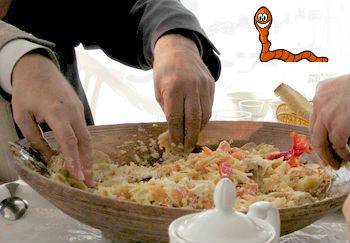
The source of infection can only be a person suffering from enterobiasis. There are rare cases when a person can become infected with pinworms from pets. The transmission mechanism is fecal-oral. The predominant route of transmission is through dirty, unwashed hands and untrimmed nails. It is not for nothing that enterobiasis is also called “the disease of unwashed hands.” Due to severe itching, a person scratches the perineal area, puts eggs on the fingers and under the nails. With these hands he can touch many things, for example, children's toys, food, furniture, towels, etc.
If personal hygiene rules are not followed, a person may again swallow pinworm eggs, and the infection will recur. Also, the helminth remains on bedding and underwear. Since pinworm eggs are microscopic and therefore light, they can be carried with dust and swallowed when inhaling air through the mouth. In adults, transmission of the parasite can occur with a simple handshake.
After a person swallows pinworm eggs, they pass through the stomach and enter the duodenum. There, under the influence of bile and various enzymes, the shell of the egg is destroyed and a mature larva crawls out of it. While these larvae reach the adult stage, they gradually pass through the entire small intestine and enter the cecum and upper parts of the large intestine. There, the parasites are already presented as mature pinworms, so they begin to multiply. After the fertilization process, males independently leave the human body, and females attach to the intestinal mucosa.
For the normal maturation of eggs, the pinworm receives all useful substances from the contents in the intestine, partly from the capillaries of the intestinal mucosa. The female can penetrate the mucosa quite deeply, damaging it and causing a local inflammatory reaction. The metabolic products of the helminth enter the patient’s bloodstream and cause a toxic-allergic effect. As the eggs mature, the female's uterus enlarges and stretches, as a result of which the sucker moves and the helminth detaches from the intestinal wall.
Next, the pinworm with lumps of food and due to peristalsis descends to the rectum. Usually at night, when a person's posterior sphincter muscle is relaxed, the fertilized female emerges from the anus and lays eggs in the perianal folds. When a person does not take care of the perineal area, pinworms may increase the time they lay eggs. At the same time, it can actively move from the anus towards the genitourinary organs. Sometimes the parasite can enter the vagina and move even higher - into the uterus and fallopian tubes. After the female has laid eggs, she dies. The cycle repeats again when the sick person, scratching the itchy places, does not wash his hands, and again swallows the eggs.
- Stool analysis for enterobiasis: how to prepare and take it
Can worms be transmitted from a cat to humans?
Human disease with feline helminth infections (feline roundworms, echinococci) has not been proven. The cat fluke (opisthorchis) is not transmitted from a cat to humans. A cat gets opisthorchiasis in the same way as a person: through fish .
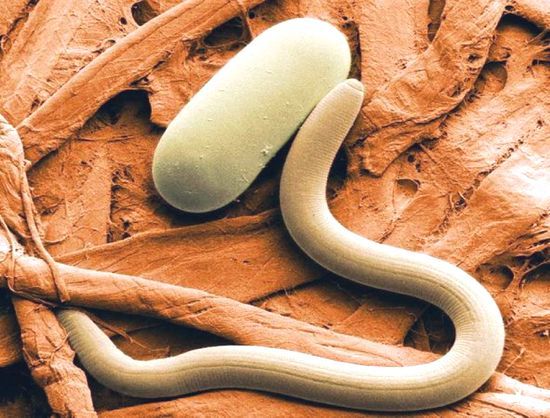
The following can be transmitted from a cat to a person:
- Toxoplasmosis is caused by protozoa. It is excreted in the feces of cats. To avoid infection, you should wash your hands after contact with the animal. Another route of infection is eating raw beef meat. In healthy people, the disease proceeds without complaints. In case of severe immunity disorders (HIV infection, cancerous tumors), the disease wakes up and causes disorders of the brain (encephalitis). Infection in pregnant women is dangerous: miscarriage and the birth of a sick child occur.
- Microsporia . This is a fungal skin disease of childhood. Highly contagious.
Domestic cats must be tested for microspore carriage.
Are dog worms transmitted to humans? What dog worms are transmitted to humans?
- from toxocariasis. Toxocariasis eggs are excreted in dog feces. The larvae enter the internal organs after ingestion and cause inflammatory and allergic changes.
- Echinococcosis is an infestation in which dog worms are also transmitted to humans through excrement. Infection is possible when collecting contaminated berries in the forest. Hunting dogs get sick more often: they become infected by eating other animals. Helminths settle in the internal organs (liver, spleen, brain, lungs) and form cavities - cysts. Treatment of the disease is surgical.
Symptoms of enterobiasis in adults
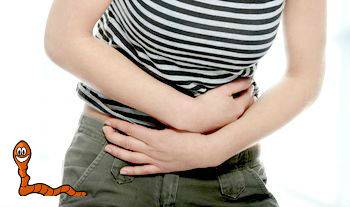
The incubation period is usually up to 2-6 weeks. The clinical picture of enterobiasis is varied and depends on the number of pinworms that are in the body, the frequency of auto-infections, the individual reaction of the human body, and the presence of concomitant pathology. The most striking complaint that worries all patients with enterobiasis is itching in the perianal area. Its intensity depends on the massiveness of the invasion. If the infection is mild, the itching is usually low-intensity and periodic (mainly at night). If there are a lot of pinworms, then the itching is constant, pronounced, unbearable. Such itching often adversely affects the general condition of the patient: the person develops insomnia, irritability, headaches, weakness, and decreased ability to work. With prolonged infection, changes in the digestive canal are observed, such as:
- loss of appetite;
- slight loss of body weight;
- periodic nausea, vomiting;
- bloating and rumbling;
- cramping abdominal pain;
- diarrhea.
The presence of pinworms in the body can lead to a number of complications. The most dangerous complication is the development of acute appendicitis when the parasite gets into the appendix. With massive infection, helminths can perforate the intestinal wall and cause the development of peritonitis. Also, pinworm contributes to the formation of dysbiosis and suppression of the immune system. In women, complications such as vaginitis, vulvovaginitis, and endometritis are possible.
Ascariasis
Roundworms (Latin - Ascaris lumbricoides - similar to an earthworm) are one of the most studied parasitic worms. The old Russian name is stringets.
Roundworms live in the small intestine of humans. The female is a round, smooth, slightly curved worm that can reach a length of 40 cm. In the male, the tail end is bent in the form of a hook. He is smaller than the female. The length of the male, as a rule, does not exceed 25 cm. Live roundworm is dark red. When it dies and is excreted in feces, its color usually turns yellowish-white or brown.
During the day, a female roundworm releases up to 240 thousand eggs, inside of which there are larvae. The eggs end up in the soil with feces. To mature and become infectious to humans, they must lie in the ground for several weeks. Infection occurs when only a mature egg is ingested.
The journey of roundworm in the human body
The roundworm egg enters the stomach with food and then into the small intestine. During this time, a living larva hatches from it, which very quickly penetrates the blood vessels and is sent through the bloodstream to the liver, and then to the lungs. In the lungs, roundworms ascend through the bronchi to the trachea. The larvae irritate the bronchial mucosa, causing coughing with sputum. The sputum is swallowed, and the larvae are swallowed along with it.
So the roundworm ends up in the stomach again, enters the intestines, where it remains completely, gradually growing into an adult worm. If it is a female, then after some time roundworm eggs will appear in the human feces; if it is a male, then there will be no eggs. But usually both males and females settle in the intestines. Quantity – from one, two to several dozen. The entire journey of roundworms through the human body from the moment of infection to the appearance of a new generation of eggs in the feces takes about 3 months.
You should know that roundworms do not reproduce in the human intestine. The number of eggs that reach a person equals the number of adult parasites. The roundworm lives for about a year and then dies, excreted in the feces in the form of a whole worm or individual fragments.
Symptoms of ascariasis
While in the human body, roundworm larvae secrete toxic substances - allergens that cause allergy symptoms.
Hives may suddenly appear on the child’s body, and antiallergic drugs help temporarily or incompletely. Somewhat later, intermittent abdominal pain, bloating, sometimes nausea, restless sleep, and loss of appetite occur. Then the allergy symptoms begin to subside, and sometimes a long worm, roundworm, is suddenly discovered in the child’s feces. After this, the allergy goes away without a trace, and the parents forget about it.
In some cases, when a lot of ascaris eggs enter the body (massive infestation) or when there are disturbances in the functioning of the immune system, the disease can be very severe:
- -increase in body temperature to 38⁰C and above;
- -cough, very persistent, especially at night;
- - attacks of suffocation are possible, as with bronchial asthma;
- -Children may develop swelling of the larynx - false croup.
Usually the correct diagnosis is not made during this period. The doctor diagnoses a cold with allergy symptoms , acute bronchitis, pneumonia. After a few days, the condition improves, but the child becomes restless, refuses the usual food, complains of nausea, abdominal pain (sometimes very severe, as with appendicitis), and often grinds his teeth at night.
After some time, when examining the child’s stool, roundworm eggs are discovered, and sometimes the worm itself, alive or dead. In these cases, you need to consult a doctor who will prescribe tests and medications. You cannot self-medicate. Is it dangerous.
Complications
Intestinal obstruction. A very dangerous complication. Usually occurs in young children. The cause may be blockage of the intestinal lumen by a ball of roundworms.
Vomit. Sometimes roundworm for some reason rises into the stomach. This is usually accompanied by vomiting, and a worm can be found in the vomit. The complication most often occurs in excitable, nervous children, but it is also possible in completely calm adults.
How to treat ascariasis
There are a number of highly effective drugs - Vermox, Pyrantel, Decaris, Medamin. However, we remind you once again that the dose of the drug and the treatment regimen should be determined only by a doctor.
Prevention
It should be remembered that in addition to the fact that the roundworm produces an extremely large number of eggs, these eggs are very stable in the external environment. After all, they have a thick, lumpy shell. These eggs overwinter well in the ground, and in compost heaps they can remain viable for up to 10 years.
As already mentioned, infection with roundworms occurs as a result of eating unwashed fruits, vegetables, and herbs on which particles of earth remain. It doesn’t matter at all whether you wash vegetables and herbs with boiled water or tap water. It is very important to soak the greens in water and then rinse with running water.
When washing greens and berries, it is recommended to follow the following rules:
- -Cut the roots of the greens, and tear off the sepals of the strawberries;
- - Briefly fill the food with water, drain the water;
- -Place in a colander and rinse thoroughly with running water.
Now you can safely use the products. Infection with roundworms is no longer a threat.
Diagnosis of enterobiasis
Diagnosis of enterobiasis in adults is not difficult and specific. Although the main clinical sign of perianal itching when infected with pinworms is present, it is impossible to accurately diagnose it. This problem can occur with infections of the genitourinary system, hemorrhoids, diabetes mellitus, and neurodermatoses. Therefore, to make a diagnosis it is necessary to conduct a laboratory test. There are practically no changes in the blood test. Only with prolonged and massive invasion can there be an increase in the number of blood eosinophils. A scatological examination for enterobiasis is not informative, since pinworm eggs are located near the anus and do not enter the feces.
The most important method for detecting helminth eggs and adults is microscopic examination of scrapings taken from the perianal folds. The analysis is usually done in the morning. You cannot wash yourself, take a shower, or go to the toilet before scraping. There are several options for taking material for analysis:
➡ 1. Using adhesive tape or tape (Graham method) - a piece of tape is applied to the anus, and then an imprint is made with this piece on a glass slide and examined under a microscope.
➡ 2. Using a cotton swab moistened with saline, glycerin and water - this swab is passed around the anus, and then it is placed in a small sterile container and sent for examination.
➡ 3. Taking smears from the perianal folds using a sterile glass spatula and transferring the material onto the glass.
The first two methods can be done at home. But the material must be delivered for examination no later than 2 hours later. If adult pinworms were found during the scraping process, they are treated with ethyl alcohol and also sent to the laboratory. According to scientific research, scrapings for enterobiasis are recommended to be done at least 3 times every 5-7 days, since pinworm eggs may not always be detected during the first examination.
Treatment of the disease
Treatment of enterobiasis in adults comes down to eliminating parasites from the body and following simple hygiene rules. To prevent a person from re-infecting himself and spreading the infection to others, daily hygiene of the body, and especially the perineum, is necessary. It is necessary to wash your hands before eating, keep your nails well-groomed, and wean yourself from the habit of biting your nails. It is advisable to change bed linen 2 times a week and underwear 2 times a day.
- Analysis for enterobiasis: how it is carried out and how to prepare for it
To destroy eggs and helminths, it is necessary to iron the laundry after each wash. If you are very bothered by itching in the anal area before going to bed, you can do an enema with a soda solution. To do this, take half a teaspoon of baking soda and dissolve it in a glass of warm boiled water. Such an enema is not capable of removing all helminths from the body; it only removes those pinworms that are in the lumen of the rectum and near the anus. In case of massive infection, you can place a tampon soaked in Vaseline in the perianal folds overnight. It prevents the spread of helminths to the organs of the genitourinary system.
To eliminate the development of complications and auto-infection, antiparasitic agents are used:
➡ 1. Albendazole - the drug affects the muscular system of the worm, disrupts energy metabolism and absorption of nutrients in the body of the pinworm. Effective against both adults and larvae. Adults are prescribed 1 tablet (400 mg) once, after 3 weeks you need to take the tablet again in the same dose. This cycle is repeated until negative results of microscopic examination of the scraping are obtained. The drug should not be prescribed to pregnant women and persons with liver cirrhosis.
➡ 2. Vermox - disrupts the absorption of glucose and depletes its reserves in the parasite’s body, blocks the formation of energy. You need to take 1 tablet (100 mg) once, then repeat after 2 weeks at the same dosage.
➡ 3. Pyrantel - blocks the nerve endings in the muscles of helminths, resulting in their immobilization. The drug is taken orally once at a rate of 10 mg/kg after breakfast for 3 days.
➡ 4. Medamin - the drug blocks the transmission of nerve impulses in the muscles of the worm, as a result of which the parasite cannot attach to the intestinal wall. Prescribed orally at a dose of 10 mg/kg/day once (divided into 3 doses within one day) after meals. It is recommended to take a course with the same dose again after 2 weeks.
➡ 5. Piperazine adipate - paralyzes the muscular system of the helminth, which leads to its immobilization and death. Take 1.5-2.0 g 2 times a day for 5 days. Then you need a break of 7 days. Afterwards, take it again in the same doses.
➡ 6. Levamisole is an immunostimulant that increases cellular immunity due to increased formation of T-lymphocytes. The initial dose is 150 mg per day. The drug is taken for a long time, because the effect develops gradually.
If there is severe itching around the anus and if allergic reactions occur, antiallergic drugs can be prescribed:
- Treatment of enterobiasis in adults: treatment regimen with folk remedies and medications
— loratadine — 1 tablet (0.01 g) 1 time per day;
— Erius — 1 tablet (0.005 g) 1 time per day.
In the treatment of insomnia and irritability, sedatives are used. However, if all helminths are removed from the body in time and completely, then all psychoneurological symptoms will go away on their own.
Treatment of enterobiasis with folk remedies
Enterobiasis is one of the most harmless helminthiases. Only if you do not seek help and do not treat for a long time, you can get complications. Therefore, in this case, in order not to burden the body with not entirely harmless medications, you can turn to folk remedies:
- Sauerkraut juice is not only rich in vitamin C, but can also remove pinworms from the human body. You only need to take 1 glass 2 times a day (morning and evening) after meals.
- Pumpkin seeds have proven themselves well. Take 100 g of peeled seeds and pour in 100 ml of olive oil. This mixture is eaten in the morning before meals. Take within 3 days.
- You can make an infusion of thyme. To do this, you need to take 2 tablespoons of ground thyme and pour 200 ml of boiling water over them. Leave for a couple of hours, then strain and drink at once. Make this infusion for 5 days.
- Effective against pinworms and garlic. You need to take a couple of cloves of fresh garlic, chop them and pour boiled water at normal temperature. Drink the tincture before bed. Do this for 3 days in a row. It is advisable to take this infusion again after 1 week.
- Beetroot juice has anthelmintic properties. To do this, you will need one chopped beet, from which the juice is then squeezed out. Take 100-200 ml of juice in the morning before meals.
- There are whole herbal preparations against helminths:
